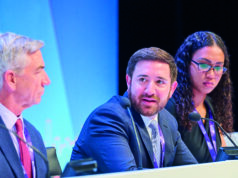
In the first of a series of webinars focusing on COVID-19, Society for Cardiovascular Angiography and Interventions (SCAI) president Ehtisham Mahmud (Cardiovascular Medicine, University of California, La Jolla, USA) and colleagues reviewed transcatheter aortic valve implantation (TAVI) procedures during the pandemic. A key point of discussion was which procedures could be categorised as essential and, thus, should be performed despite bans on elective procedures.
Pinak Bipin Shah (Brigham and Women’s Hospital, Harvard Medical School, Boston, USA) commented that, like many centres across the globe, his institution has placed a temporary ban on elective procedures (until 1 June at his centre). “Of course, we were all sitting there saying what cardiology procedure is truly elective? Because once we make a decision to refer for a coronary procedure or a structural heart procedure, particularly in the world of TAVI, generally you want to move along and get it taken care of. So, the term elective does not really make a lot of sense.”
He added that a recent paper by Canadian Association of Interventional Cardiology (CAIC) president David Wood (Centre for Cardiovascular Innovation, University of British Columbia, Vancouver, Canada) and colleagues on performing cardiology procedures during COVID-19 had a better approach of “looking at this” by reviewing what was and what was not “essential”. The paper in question, entitled “Precautions and procedures for coronary and structural cardiac interventions during the COVID-19 pandemic: Guidance from Canadian Association of Interventional Cardiology”, was published last month in the Canadian Journal of Cardiology.
For Shah, though, another issue was determining which procedures were actually essential. He said: “I think that [what is essential] is one of the things we are all struggling with right now. We all know the patients that can wait for a period of time [before undergoing TAVI] and we also know the ones that really cannot wait and must have a procedure. But, there is a large grey area between truly essential and non-essential.”
Responding to Shah, Mahmud queried whether a lack of symptoms signified that a patient did not require urgent treatment. He said: “Perhaps the first way to define ‘non-essential’ is to [examine symptoms]. We could put asymptomatic patients into the category of non-essential for eight weeks?” However, webinar panellist Kendra Grubb (Emory University in Atlanta, USA) observed that some asymptomatic patients may later move into the essential category. She explained: “They pass all of the metrics for critical [status] but they continue to not have symptoms. So, [at our centre] we have to have someone calling them on a weekly basis to ensure we do not miss any symptoms that may have developed. Those are the asymptomatic patients I would worry about.”
Wood, who was co-chairing the webinar with Mahmud, had a similar view to Grubb. He said that the “essential” category was a “moving target”, adding: “In Vancouver, we are having a virtual heart team discussion. I think there are many different things you can look at. It is dynamic, and you have to go with the clinical judgement of you and the heart team.”
In terms of patients who were clearly in the essential category, Molly Szerlip (Interventional Cardiology, Heart Hospital Baylor, Plano, USA) noted that a patient with class III or IV New York Heart Association (NYHA) heart failure would have “pretty severe” symptoms and, thus, was at increased risk of “having a problem in the future”. Therefore, for them, a TAVI procedure was essential.
Kim Guibone (Beth Israel Deaconess Medical Center, Boston, USA), who is a nurse practitioner, spoke about how patients in the “non-essential” category receive medical attention, remotely. She said: “We take very great care to closely monitor patients, at least weekly, with ongoing risk stratification. Including in those calls is COVID-19 screening, checking for progression in aortic stenosis symptoms, and encouraging heart failure self-management. Then, we do a safety check. Do they have an ability to get groceries? To get medication. Can they manage their medication? Do they have support and are they practising safe distancing?”
As well as reviewing which procedures were essential, Mahmud et al also looked at which services centres would be able to provide during a pandemic. Wood explained that, in the aforementioned paper, he and his colleagues (including clinical ethicist Alice Virani) developed an “ethical framework” that outlined which services could be performed depending on the availability of resources. For example, when there was a “level 1” (i.e. minor) restriction in resources, patients at high-risk of a cardiovascular event in the short term could undergo TAVI but only if they were expected to have a short length of stay with minimal impact on bed capacity. However, at level 3 (complete inability to provide services due to staff/resource limitations), likely no TAVI cases could be performed.
Grubb commented that, as a surgeon, she was being asked not to perform open surgery because that required ventilators, which were needed elsewhere. “For TAVI patients, if we choose patients that can go down the minimalist TAVI pathway, then we can treat them without using the very scarce resources,” she stated.
Mahmud also raised the issue of the risks of bringing a patient “in from their safe home” for a TAVI procedure even if it was essential. He said: “We are potentially exposing them to COVID-19”. Wood added: “It is all about risk vs. benefit. If a patient is at risk of a cardiovascular event in the near future, I would argue that benefit outweighs the risk. It is about appropriate risk stratification and the appropriate patients.”
The webinar was a joint venture between SCAI and the Canadian Association of Interventional Cardiology













